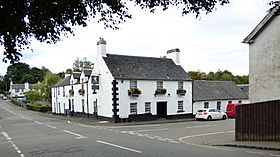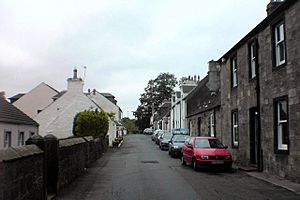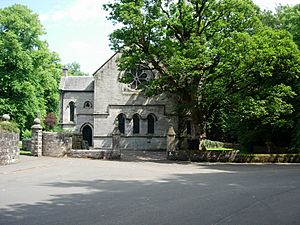Houston, Renfrewshire facts for kids
Quick facts for kids Houston
|
|
|---|---|
 Main Street in Houston |
|
| Population | 6,360 (2020) |
| OS grid reference | NS404667 |
| Civil parish |
|
| Council area | |
| Lieutenancy area | |
| Country | Scotland |
| Sovereign state | United Kingdom |
| Post town | JOHNSTONE |
| Postcode district | PA6 |
| Dialling code | 01505 |
| Police | Strathclyde |
| Fire | Strathclyde |
| Ambulance | Scottish |
| EU Parliament | Scotland |
| UK Parliament |
|
| Scottish Parliament |
|
Houston (pronounced HOO-stən) is a village in Renfrewshire, a region in west central Scotland. It sits in the Gryffe Valley next to the River Gryffe. Houston is about 6 miles (10 km) north-west of Paisley. It is the biggest village in the area known as Houston and Killellan. This area also includes the nearby village of Crosslee and other small places.
Houston grew up around a castle and a church from the 1500s. The church was named after Saint Peter. Because of this, the area used to be called Kilpeter, which means "Saint Peter's Church" in Scottish Gaelic. The older part of the village you see today was mostly built in the 1700s. It was a planned community, meaning it was carefully designed.
In the past, people in Houston worked in farming and cotton weaving. Since the mid-1900s, Houston has grown a lot. It now includes areas like Craigends. This growth has made it a popular place for people who work in nearby Glasgow and Paisley to live.
Contents
History of Houston
How Houston Got Its Name
Houston was first known as Kilpeter. In the mid-1100s, a man named Hugh of Pettinain was given the land of Kilpeter. Over time, the land became known as Houston, which means "Hugh's town" or "Hugh's manor."
Old church records also mention the village. In 1225, a church document called a Papal bull mentioned "Villa Hugonis," which means "Hugh's Village." Later, in 1265, another document listed the church of "Howston."
Early Days of the Village
People have lived in the Houston area for a very long time. In the 1970s, a Bronze Age burial site was found here. This shows people lived here thousands of years ago. There was also a Roman fort nearby on Barochan Hill.
The first village was built around the Church of St Peter and Houston Castle. Today, the church is still there, and parts of the old castle are inside Houston House. The castle belonged to Hugh of Pettinain's family, who later became known as the Houstons of Houston. The family owned the castle until 1740.
In the 1700s, the owner of the land decided to move the village. He used stones from the old castle to build new homes. These new homes were for weavers. This new village was built in 1781. It was a planned community with two main streets: North Street and South Street. This design helped people access water for washing and supported the weaving industry. This older part of Houston is now a special "conservation village."
A special old stone cross, called the village's mercat cross, is still in the new village. It has parts from the 1300s. It also has a large sundial. This cross has become a symbol for Houston.
Modern Times
In the 1800s, two railway stations were built near Houston. However, they were not in the village itself. This meant Houston did not grow as fast as other nearby villages. It stayed a smaller village until the mid-1900s. Then, it became a popular place for people to live and travel to work in bigger cities.
From the 1600s to the 1800s, the main job in Houston was weaving. Later, the River Gryffe helped power a cotton mill. Other small businesses, like embroidery, also started in the village.
Important Places in Houston

Houston's old village center is a special area. It has the main pubs, small shops, and the Post Office. North Street and South Street have many traditional white cottages. Some of these homes are from the 1600s. The old village was planned so that people could easily use the Houston Burn for washing.
Some parts of the 1500s Houston Castle can still be seen. They are mostly on the land of the current Houston House. This area is next to Houston and Killellan Kirk, the local church. It is thought that Lord Darnley, who was married to Mary, Queen of Scots, might have lived at the castle for some years.
The Barochan Cross is a tall Celtic cross that might be from the 700s. It used to be near Houston. To protect it from weather, it was moved to Paisley Abbey. You can see it there today.
The Craigends Yew is a very old yew tree in the area. It might be about a thousand years old, making it the oldest living thing in Renfrewshire. Houston also has two old wells. People once believed these wells had healing powers. St Fillan's Well is near Kilallan Kirk, and St Peter's Well is also in the village.
The main Church of Scotland church, Houston and Killellan Kirk, is east of the old village. There is also a Roman Catholic church, St Fillan's, built in the 1800s.
Religion in Houston
Houston has a long connection with Saint Peter. This is why the village was once called Kilpeter. The current church, Houston and Killellan Kirk, was built in the 1870s. It replaced an older church from 1775. The church was built as a memorial to Archibald Alexander Speirs, who died young.
The church parish of Houston and Killellan was formed in 1771. This happened when the parishes of Houston and Killellan joined together. The old church in the nearby village of Killellan was left empty. Its ruins, which are very old, are now protected. An evening church service is still held there once a year.

St Peter's Well is a special old well. It is covered, which is rare for holy wells. People once thought its water would help travelers return home safely.
The Houston and Killellan church hall on Main Street was built in the 1840s. It was for a different church group at the time. After a fire in 1941, it was rebuilt and became the church hall it is today.
St. Fillan's Roman Catholic Church on Main Street was built in 1841.
Community Life and Activities
Houston has many community groups and events. The main park, Houston Public Park, is next to the old village. There are also other parks in newer parts of the village.
Houston Public Park hosts the village's yearly agricultural show in the summer. This show is organized by the Houston and Killellan Agricultural Society. Another big event is the Kirk Carnival. It has a parade, stalls, and fun activities. Local primary schools also take part.
In 1992, the Strathgryffe Tennis Squash and Fitness Club opened in the village. It offers tennis, squash, and fitness activities. There is also a riding club nearby for horse lovers. A foxhunt group has been based in the village since 1850.
The John G. Fleming Bowling Club is a lawn bowls club in Houston. It was started by a local landowner to celebrate Queen Victoria's 60 years as queen.
Schools in Houston
Gryffe High School is the main secondary school for Houston and nearby villages like Bridge of Weir. It is a non-religious school for both boys and girls. Gryffe High School is known for its strong academic results. In 2009, it was ranked as one of the best state secondary schools in Scotland.
Houston has two primary schools. Houston Primary School is a non-religious school. St Fillan's Primary School is a Roman Catholic school. Both are for boys and girls. After primary school, students from Houston Primary usually go to Gryffe High School. Students from St Fillan's Primary usually go to St. Benedict's High School.
The old schoolhouse in the village center is now a place where visitors can stay. Another former school building is now a community center called the Carrick Centre.
Public Services
The Police Service of Scotland looks after Houston. The closest police station is in Johnstone.
The Scottish Fire and Rescue Service provides fire and rescue services. The nearest fire station is also in Johnstone.
NHS Greater Glasgow and Clyde is the health board for the area. The closest major hospital with an accident and emergency department is the Royal Alexandra Hospital in Paisley. Houston has one medical clinic.
Scottish Water provides water and sewerage services. Renfrewshire Council collects charges for these services. The council also handles waste management. Scottish Power is the company that delivers electricity to homes and businesses.
There is a Post Office in the village. The main postal center for Houston is in Johnstone.
See also
 In Spanish: Houston (Renfrewshire) para niños
In Spanish: Houston (Renfrewshire) para niños





